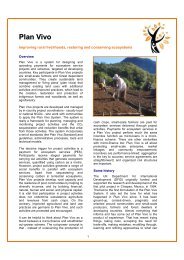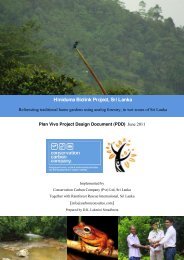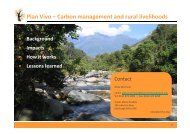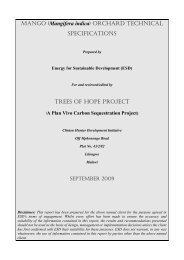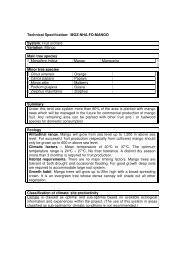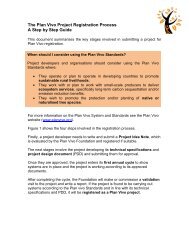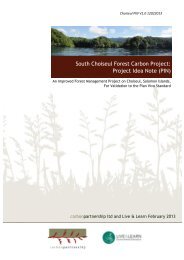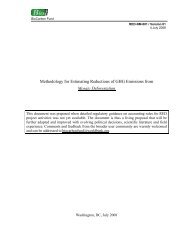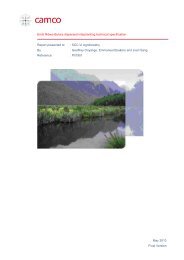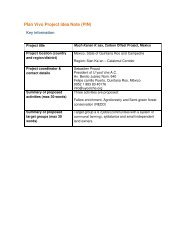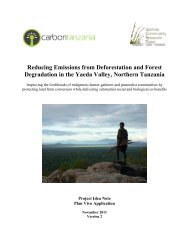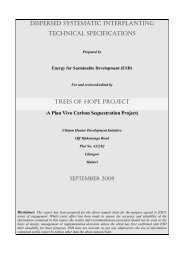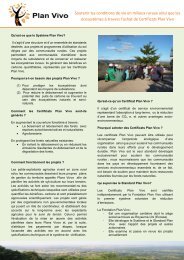Arbres locaux pour un monde meilleur | Local trees for a better world
Arbres locaux pour un monde meilleur | Local trees for a better world
Arbres locaux pour un monde meilleur | Local trees for a better world
Create successful ePaper yourself
Turn your PDF publications into a flip-book with our unique Google optimized e-Paper software.
6<br />
Comm<strong>un</strong>ity Payments <strong>for</strong> Ecosystem Services in Patako | Plan Vivo PDD 2012<br />
Assisted natural regeneration<br />
Participants will assist regenerating seedlings to become established and regeneration areas will<br />
be fenced with living fences (“haie vive” in French) to prevent seedlings being damaged by<br />
livestock grazing. Some seedlings will also be planted to enrich and assist natural regeneration<br />
processes and increase the establishment rate of economically important species.<br />
Once tree planting and management activities are <strong>un</strong>derway, it will be possible to engage<br />
comm<strong>un</strong>ities in activities that directly protect and reduce degradation of the central Patako<br />
Forest. A partnership and joint management plan in which responsibilities are shared between<br />
comm<strong>un</strong>ities and authorities from the Forest Service will be required <strong>for</strong> this project activity.<br />
Native tree species<br />
Planting native species will help to maintain and conserve biodiversity and will provide other<br />
benefits, including:<br />
• Fruits, leaves, bark and roots <strong>for</strong> food and medicine <strong>for</strong> local use<br />
• Products <strong>for</strong> sale where there is a national market in the food, cosmetics and<br />
pharmaceutical industries<br />
• Improved soil fertility through nitrogen-‐fixing<br />
• Erosion control through rooting systems that help bind soil<br />
• Fodder <strong>for</strong> livestock<br />
• Fuel wood that will be harvested sustainably<br />
4.4. Description of the Plan Vivo Technical Specifications<br />
The af<strong>for</strong>estation and agro<strong>for</strong>estry Plan Vivo technical specification is applicable to degraded land<br />
aro<strong>un</strong>d Patako <strong>for</strong>est. Agro<strong>for</strong>estry, which includes intercropping and bo<strong>un</strong>dary planting, takes<br />
place on cropland. Af<strong>for</strong>estation, which is the establishment of small plantations, and assisted<br />
natural regeneration take place on degraded, neglected, or previous agricultural land (Table 1).<br />
Table 1: Technical specification<br />
Title Type of<br />
activity<br />
Agro<strong>for</strong>estry -‐<br />
Intercropping<br />
Agro<strong>for</strong>estry -‐<br />
Bo<strong>un</strong>dary<br />
planting<br />
Tree<br />
planting<br />
Tree<br />
planting<br />
Objectives Brief description<br />
Biodiversity conservation<br />
and increased soil fertility and<br />
crop yields<br />
Biodiversity conservation and<br />
land demarcation, firewood, fruit,<br />
shade, improved soil fertility,<br />
Nitrogen fixing tree species planted at<br />
a low density throughout an area of<br />
cultivated land. Crops continue to be<br />
grown in the area and the nitrogen<br />
fixing <strong>trees</strong> improve soil productivity<br />
Trees planted along the perimeter of<br />
individual farms or comm<strong>un</strong>al lands




